8.2 What are the pressures on coastal water quality?
Coastal water quality can be affected by contaminants including sediment, nutrients, bacteria and viruses, oils, metals and biocides. These contaminants can be derived from many sources including recreational and commercial fishing/boating, shipping, consented discharges, diffuse surface run off from agricultural land and earthworks and stormwater, sewage spills and rubbish dumping from developed areas.
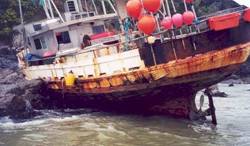 These sources are summarised into the following main pressures on coastal water quality; environmental incidents, consented discharges, catchment land use, shipping and recreational boating.
These sources are summarised into the following main pressures on coastal water quality; environmental incidents, consented discharges, catchment land use, shipping and recreational boating.
Fishing vessel grounded on rocks in Mangonui Harbour, November 2003 (right).
Environmental incidents
Environmental incidents include any pollution or unauthorised activity that may have an adverse effect on the environment. Unauthorised discharges or activities (i.e. those not permitted by a rule in a Regional Plan or consent) can have a detrimental effect on the coastal environment, in particular coastal water quality. This includes incidents such as sewage spills, sewage discharges from vessels, ballast discharges from ships, sediment discharges from earthworks, unauthorised coastal structures.
Since the environmental hotline started in 1993 there has been over 160 coastal incidents reported to the council every year. The number of incidents peaked in 2000 and 2001 with 246 and 254 coastal incidents respectively, as shown in figure 1 (below).
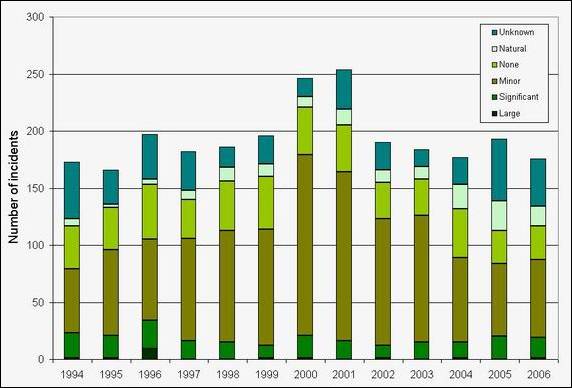
Figure 1: Number of coastal incidents reported to the Regional Council from January 1994 to December 2006 and their impact on the environment.
Over the 13-year period from January 1994 to December 2006 there has been approximately 2500 coastal incidents reported to the council, of which only 16 were reported as having a large effect on the environment as shown in figure 1 (above). A further 220 incidents (8% of the total) were reported as having a significant effect on the environment.
Oil, diesel and other fuel spills are the most common type of coastal incident reported to the council since 1994 as shown in figure 2 (below). More recently the number of incidents relating to structures and other coastal activities has increased. However there has been a subsequent drop in the number of incidents recorded as miscellaneous (shown in the ‘other" category in figure 2). This is likely to be as a result of a change in recording from ‘miscellaneous' to ‘other coastal activities', which was added to the database system as an incident type in 2002.
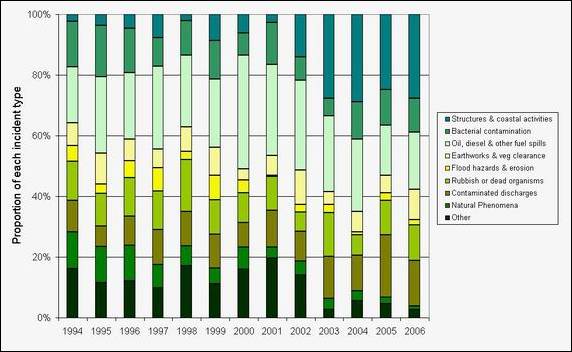
Figure 2: Different types of coastal incidents reported to the Council between January 1994 and December 2006.
Incidents causing bacterial contamination include human sewage and farm dairy effluent spills. Microbial contaminants, such as viruses and pathogens derived from animal and human effluent, adversely affect the suitability of water bodies for recreational purposes, such as swimming and shellfish gathering, and commercial and cultural purposes.
Coastal discharge consents
There has been a steady increase in the number of coastal discharge consents from 1997 to 2007 as shown in figure 3 (below). Stormwater discharges are the most common. More recently there has been an increase in the number of ‘other' discharge consents. The majority of these are for chemical use to remove algae from boat ramps within consent conditions.
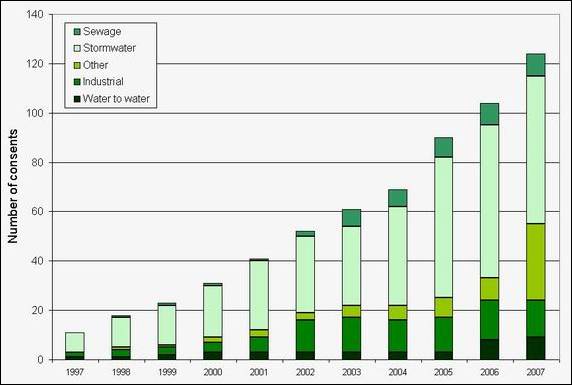
Figure 3: Number of coastal discharge consents at 1 January of each year for 1997 to 2007.
Catchment land use
The coastal environment can be affected by land use on the surrounding coastline but also land use in inland areas through contributing river catchments and stormwater discharges. This can include contaminants such as sediment, nutrients and toxicants.
Sediment discharges from land-use activities, such as earthworks, have potential to cause:
· Sedimentation of estuaries and river systems.
· Poor visual clarity of water bodies leading to reduced photosynthesis and changes in predator-prey relationships.
· Changes in sea-bed sediment composition.
· Changes to habitat, flora and fauna.
Nutrient discharges from land-use activities, primarily nitrogen and phosphorous, have potential to cause nuisance growth of aquatic plants and algal blooms.
Toxicants, including metals, hydrocarbons, biocides and others, discharged from land and coastal-based activities have potential for environmental accumulation and toxic effects, with effect usually confined to near source.
Re-suspension and redistribution of sediment already in harbours through river and coastal processes (i.e. waves and currents) is also an ongoing problem.
Shipping
The majority of Northland's commercial shipping activities are based at Port Whangarei, Marsden Point and the refinery facilities at Marsden Point. On average there are 200 oil tanker visits and 200 non-oil tanker ship visits to these two facilities. There are a further 110 visits per year made to the Portland cement out-loading facility and a largely transient fishing fleet where numbers vary between 20 - 40 vessels operating from facilities in the upper Whangarei Harbour and in other Northland harbours. There are also 20 - 30 commercial cruise ships that visit the Bay of Islands each year.
The effect of commercial shipping on coastal water quality may include:
· Contamination resulting from discharged ballast water and waste, and from anti-fouling paint.
· Contamination resulting from oil spills and other hazardous substance spills.
· Introduction of unwanted marine organisms
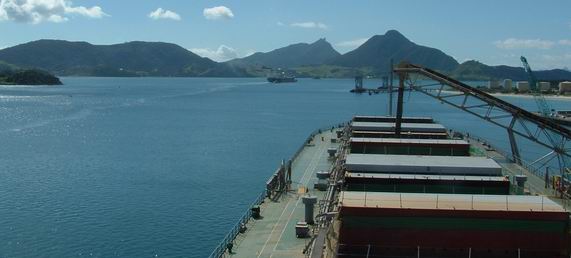
Ship being loaded at Whangarei Port.
Recreational boating
The effect of recreational boating on the water quality of open coast waters is minimal due to the relatively small group of resource users, the dynamic mixing of the surface waters by waves and the transportation of coastal water by far-reaching coastal currents.
However, in semi-enclosed coastal waters the opposite applies. Semi-enclosed waters are often popular areas of concentrated boat use. These areas have small waves and limited mixing of surface waters, coupled with restricted circulation controlled by ebb and flood-dominated tidal currents that re-circulate water. In Northland there are many semi-enclosed areas that are popular for recreational boating. Most of these areas are located on the east coast and include the Bay of Islands and the many harbours and estuaries along the length of the coast. The popularity of boating in Northland is highlighted by the fact that there are about 2800 permanent moorings and nine marinas, with increasing demand for more mooring facilities. Most of these facilities are located in semi-enclosed locations.
Concentrated boat use in semi-enclosed waters can become an environmental pressure due to the restricted circulation of water and multiple effluent discharges. Pathogens (disease-causing bacteria and viruses) contained in the discharged effluent may affect other resource users, including the aquaculture industry, shellfish gatherers and swimmers.
